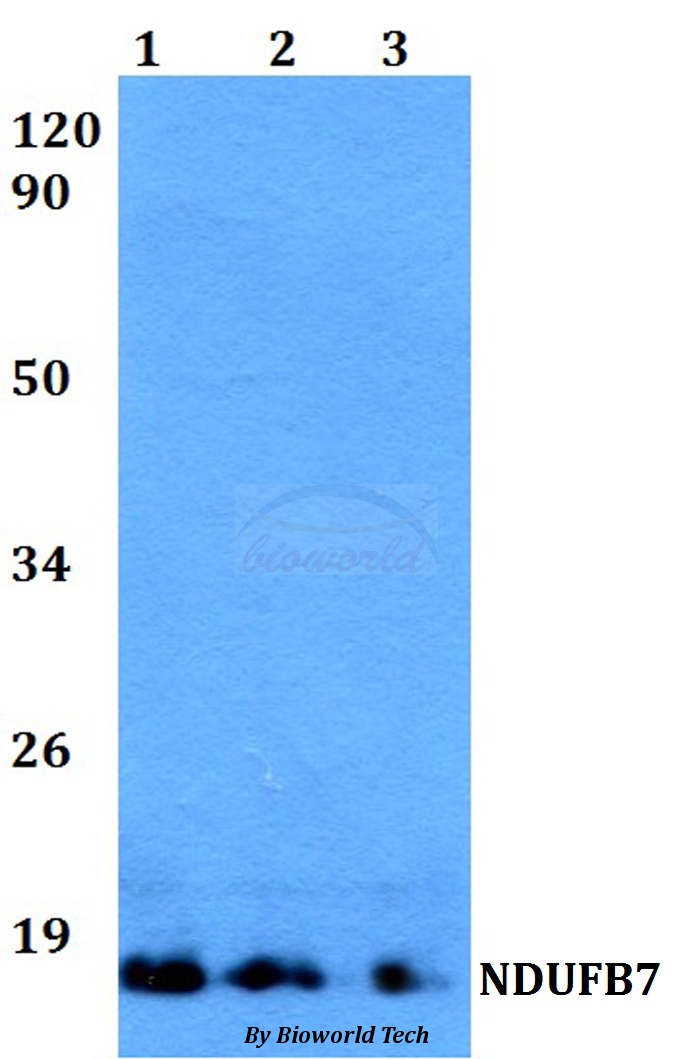Product Name :
NDUFB7 polyclonal antibody Background :
Complex 1 (also known as NADH dehydrogenase) of the electron transport chain (respiratory chain) is an enzymatic complex that catalyzes the transfer of electrons from NADH to ubiquinone. Free energy from the reaction is conserved in the transfer of protons into the intermembrane space to create an electrochemical proton gradient, a driving force for ATP synthesis. Complex 1 is a complicated, multi-protein, L-shaped complex composed of at least 45 different subunits and located in the mitochondrial inner membrane. NDUB7 (NADH dehydrogenase [ubiquinone] 1 beta subcomplex subunit 7), also known as NADH-ubiquinone oxioreductase B18 subunit, complex I-B18 (CI-B18) or cell adhesion protein SQM1, is a 137 amino acid accessory subunit of complex 1. Ubiquitously expressed, NDUFB7 localizes to the mitochondrial inner membrane on the matrix side. NDUFB7 contains a sevenfold repeat of positively-charged residues that may indicate a role in protein-protein interactions. Product :
Rabbit IgG, 1mg/ml in PBS with 0.02% sodium azide, 50% glycerol, pH7.2 Storage&Stability :
Store at 4°C short term. Aliquot and store at -20°C long term. Avoid freeze-thaw cycles. Specificity :
NDUFB7 polyclonal antibody detects endogenous levels of NDUFB7 protein. Immunogen :
A synthetic peptide corresponding to residues in Human NDUFB7. Conjugate :
Unconjugated Modification :
Unmodification
NDUFB7 polyclonal antibody Background :
Complex 1 (also known as NADH dehydrogenase) of the electron transport chain (respiratory chain) is an enzymatic complex that catalyzes the transfer of electrons from NADH to ubiquinone. Free energy from the reaction is conserved in the transfer of protons into the intermembrane space to create an electrochemical proton gradient, a driving force for ATP synthesis. Complex 1 is a complicated, multi-protein, L-shaped complex composed of at least 45 different subunits and located in the mitochondrial inner membrane. NDUB7 (NADH dehydrogenase [ubiquinone] 1 beta subcomplex subunit 7), also known as NADH-ubiquinone oxioreductase B18 subunit, complex I-B18 (CI-B18) or cell adhesion protein SQM1, is a 137 amino acid accessory subunit of complex 1. Ubiquitously expressed, NDUFB7 localizes to the mitochondrial inner membrane on the matrix side. NDUFB7 contains a sevenfold repeat of positively-charged residues that may indicate a role in protein-protein interactions. Product :
Rabbit IgG, 1mg/ml in PBS with 0.02% sodium azide, 50% glycerol, pH7.2 Storage&Stability :
Store at 4°C short term. Aliquot and store at -20°C long term. Avoid freeze-thaw cycles. Specificity :
NDUFB7 polyclonal antibody detects endogenous levels of NDUFB7 protein. Immunogen :
A synthetic peptide corresponding to residues in Human NDUFB7. Conjugate :
Unconjugated Modification :
Unmodification
-
 Western blot (WB) analysis of NDUFB7 polyclonal antibody at 1:500 dilution Lane1:Hela whole cell lysate Lane2:sp2/0 whole cell lysate Lane3:PC12 whole cell lysate
Western blot (WB) analysis of NDUFB7 polyclonal antibody at 1:500 dilution Lane1:Hela whole cell lysate Lane2:sp2/0 whole cell lysate Lane3:PC12 whole cell lysate
Bioworld Biotech only provide peptides for our antibodies and do not provide additional peptide customization services.
Price/Size :
USD 368/1mg/vial
Tips:
For phospho antibody, we provide phospho peptide(0.5mg) and non-phospho peptide(0.5mg).Describe :
Blocking peptides are peptides that bind specifically to the target antibody and block antibody binding. These peptide usually contains the epitope recognized by the antibody. Antibodies bound to the blocking peptide no longer bind to the epitope on the target protein. This mechanism is useful when non-specific binding is an issue, for example, in Western blotting (WB) and Immunohistochemistry (IHC). By comparing the staining from the blocked antibody versus the antibody alone, one can see which staining is specific; Specific binding will be absent from the western blot or IHC performed with the neutralized antibody.Formula:
Synthetic peptide was lyophilized with 100% acetonitrile and is supplied as a powder. Reconstitute with 0.1 ml DI water for a final concentration of 10 mg/ml.The purity is >90%,tested by HPLC and MS.
Storage:
The freeze-dried powder is more stable. For short time at 2-8°C. For long term storage store at -20°C.
Note :
This product is for research use only (RUO only). Not for use in diagnostic or therapeutic procedures.
 NDUFB7 polyclonal antibody
NDUFB7 polyclonal antibody  Datasheet
Datasheet COA
COA MSDS
MSDS SHIP
SHIP